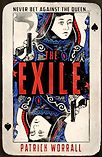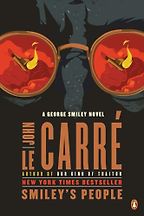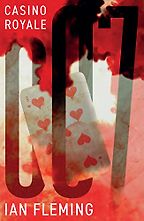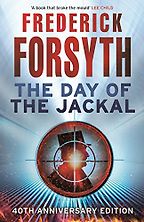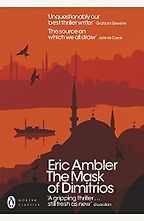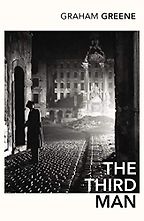You’ve chosen a selection of classic spy thrillers set in Europe, mostly in the decades after World War II. Is that what you like to read?
The thing with me is that I don’t read the new stuff. It’s mostly because I’m scared of inadvertently stealing things from other writers. There’s a way in which we can all end up writing in the same style, doing the same things: a groupthink sets in. Writers are a nervous breed, fundamentally, and we do tend to herd. It’s hard to be brave and original and you have to force yourself to try to do that.
So I generally avoid people writing in the same genre, which always surprises people because they ask, ‘Don’t you read all the time?’ I do, just not books that are similar to the things I write.
How did you come to write about Europe in this period?
The first book I wrote was called The Partisan. It came about almost like a secondary school creative writing exercise set by the teacher, where someone gives you a photograph—let’s say a historic photograph of someone or something interesting—and you have to write the back story. It’s as simple as that.
My wife is Lithuanian and about ten years ago I was in Lithuania in a place called Fort Nine, outside the city of Kaunas. I saw a photograph of three teenage girls, partisans, posing with German guns. I presume they’d taken them from an unfortunate German patrol. It was one of the most astonishing things I’ve ever seen in my life—how young they were, the obvious risk that the whole thing carried, how much fun they were having. They were smiling. One of them had a cigarette dangling from her lips. She’s posing like a film star. Why did they photograph themselves? You might think that was a foolish thing to do with the SS after you. The only explanation is that they didn’t think they’d live long enough for it to matter.
Lithuania and the Baltic states don’t come up much in the spy novel genre, so I enjoyed that setting: it’s a history I’m less familiar with.
It’s funny you say that. At the time I thought, ‘No one’s ever written about the Baltic states.’ Then I reread Smiley’s People, one of the books I’ve chosen. One of the subplots of le Carré’s story is that there are Estonian émigrés living in London. They are implacable enemies of the Soviet Union, of course, because like Lithuania their country has been illegally occupied by Soviet forces. They are working with British intelligence—not in a very happy or effective way, it has to be said. I’d completely forgotten that thread in le Carré’s story, but maybe it was there in my subconscious…
Let’s start with Smiley’s People then, which actually hasn’t been recommended on Five Books before, though many of John le Carré’s books have. It features George Smiley, who appears in other of his books. Can you set the scene, for those of us who haven’t read it? Is it a good one?
Everyone has read Tinker, Tailor, Soldier, Spy, which I would say is unquestionably one of the greatest ever espionage novels, perhaps simply one of the greatest novels of the 20th century. Tinker, Tailor is a whodunit, essentially. It’s not literally a country house murder mystery, with a lineup of characters including Colonel Mustard. But there are four of them and it’s about finding out which one is the mole (a word which, I think, le Carré invented)—the Soviet traitor in the ranks of British intelligence. It’s such a great plot and it mirrors life very closely. It’s essentially about the Cambridge spy ring and the real-life traitors who worked for Stalin after the war.
Smiley’s People is the follow-up. George Smiley comes out of retirement and does a bit of detective work. It’s a redemption story: a chance for Smiley to tie up the loose ends of his life and career. He gets a shot at his nemesis, the head of Russian intelligence—code name Karla, who is this fiendishly cunning Soviet spymaster. It’s a duel between these two old foxes, if you like.
Smiley has this very gentle detective manner about him. There’s almost no violence, there are no car chases. It’s not that kind of book at all. It’s a cerebral book about somebody getting to the heart of a tangled story. It’s brilliant. I think it’s better than Tinker, Tailor. I won’t give away the ending, but it has a very satisfying sense of closure to it. It’s wonderfully written.
Is it set in London?
It’s mostly set in London. There are forays into Europe. There are things that le Carré does which always astonish me. When I read it again, it stopped me in my tracks. He’s a great exponent of what Hemingway called ‘the iceberg theory’ where you just see the tip and the rest of the iceberg is implied. With just a few lines, you get the sense of another whole world and a story expanding there.
One of the things he does that is so clever is that we follow George Smiley and realize that everyone else has this enormous respect for him. He’s seen as this legendary figure, but it’s never quite fully explained why. Then there’s this tiny little flash in the book where it talks about Smiley being undercover in Nazi Germany during the war. As a matter of historical record, I don’t think any British intelligence officers ever really did that—I don’t think anyone could have pulled it off. But that is the making of the legend. In just one or two sentences you get this sense of an awful sacrifice that he’s made personally in early life. That’s set him up for the rest of his life so that people speak about him in hushed tones. It’s very, very subtly done.
Let’s move on to Casino Royale, the first of Ian Fleming’s books.
This is totally different. We’re at the other end of the scale here, in terms of thrillers and espionage. Broadly, the way I look at it is that at one end of the scale, there are people like le Carré. The books are very cerebral and clever and authentic. They can feel a little bit static and conversational: they’re not really thrillers in that it’s not thrills and spills and action.
At the other end, there are books like James Bond, which are very exciting but not cerebral at all. I suppose I’ve always clung to the belief that somewhere there’s a middle ground to be found, where you can write something which is propulsive and kinetic and action-packed, but also clever. A life’s work is probably finding that sweet spot and I don’t suppose I’ve done it yet but, broadly, that’s my mission.
Fleming knew a bit about intelligence work—like John le Carré and so many of these writers. It’s a bit disputed what Fleming actually got up to in the war, but he was involved in naval intelligence. Casino Royale was his first book.
I have a complicated relationship with Ian Fleming. I find his racism and sexism and homophobia difficult, although the books are a product of their era: we have to judge people by the standards of the time they lived in. But it’s impossible to get away from him. If you’re trying to write anything vaguely action and espionage-related, it’s this presence that’s always there. At some point, you have to come to terms with it.
Casino Royale interests me because it’s about the relationship between Britain and the foreign, exotic world. In the book, we actually only get as far as Northern France. That’s probably about as much exoticism as any British reader could handle in 1953, before the age of mass tourism. There’s a fair amount of post war drudgery and reconstruction in Britain. It was this fairly dull, grey world and France was this impossibly glamorous Other: a world of gambling and premarital sex and fine dining and champagne.
Casino Royale was this irresistible piece of escapism that Fleming wrote. And Bond is, of course, this irresistible figure. If you’re a young man reading Fleming in 1953… here’s a man going on adventures, entangling himself with women who don’t appear to expect him to produce an engagement ring.
My latest book, The Exile, is set much in the same period, in the early 1950s, and I was very interested in the idea of luxury and glamour and temptation. My book has a heroine, not a hero, but she ends up in Paris. She’s come from the austere world of the Eastern bloc and is surrounded by these constant temptations—champagne, cocaine, parties, young suitors. Can she survive? Can she retain the moral purity that’s there in her character or will she be tempted away from the path of righteousness by all the temptations of Paris?
Casino Royale was a book that I kept going back to. I had it in mind as a model as I wrote mine.
Fleming does ruin the whole thing. There’s a conversation where James Bond is impressing the girl. He’s ordering food for her (of course!) and he says, ‘Should we have the ‘45 Taittinger, or the ‘43?’ He’s bullshitting about wine and then he orders an avocado pear for dessert. It’s a terrible faux pas and the whole facade slips. You realise that Ian Fleming almost certainly wasn’t as sophisticated as he would have us believe.
If someone hasn’t read your book The Partisan yet, do they need to do that before embarking on The Exile?
No, it’s a standalone book. It’s got my favourite character. My heroine, in every sense of the phrase, is a woman called Greta, who’s a Lithuanian partisan. It’s a series of novels about her and her journey from somebody who is run over by history and powerless, to somebody who is a very strong, cold warrior after the war.
But if you’re writing about early 1950s France, you can’t really get away from books like Casino Royale. In some ways, what I was trying to do with The Exile was to remind people a little bit of books like that, but subvert them. Women are decorative in the Bond books, whereas my books are pretty much always based around heroines rather than heroes.
Let’s turn to Frederick Forsyth (the only one of these authors who is still alive) and The Day of the Jackal.
This is another book you can’t get away from. It’s set in France, a little bit later than the book I’ve written. My book is set in what the French call the Fourth Republic—post-war, post-Vichy, to the ascendancy of Charles de Gaulle. It was a period of tremendous political chaos in France and enormous violence. France was losing its colonies in Algeria and Indochina and it was not going to give them up without a fight.
France was thrashing around as it lost its status as a world power. There is an obvious parallel, in my mind, between France of that period and Russia today. Vladimir Putin’s Russia is a country that’s failing to come to terms with its demotion from world power status. It’s behaving with this wounded kind of violence, there’s a self-harm to it. And that was France, really, from 1946 to 1958.
The Day of the Jackal is about Charles de Gaulle and an attempted assassination attempt on him. Forsyth is interested in French history, and the darkness in it. This book is about a real-life right-wing group called the OAS. It was a secret organization, a group of authoritarian army officers, who were trying desperately to hold on to Algeria. They didn’t like the fact that de Gaulle eventually, belatedly, realized that there was no hope of Algeria staying part of metropolitan France. And there was an attempted coup and assassination on him in real life.
Forsyth writes this book in what is often described as a documentary or journalistic style. He was a journalist and he applies that way of writing to these events. It’s a very interesting book. It’s always longer than you remember and it unfolds over quite some length. Because it’s so tightly written, you forget how much happens in it.
I would say that it’s a book that follows the style of Dashiell Hammett in the late 1920s. There’s very little interiority. We spend very little time in the hero’s head. He reveals himself through action and through dialogue. It’s a very disciplined, cinematic way of writing and it reads a bit like a movie script, which I quite like.
I remember hearing on the news about the capture of the real-life assassin who was nicknamed Carlos the Jackal. I guess he was named after this book?
I think he was, because the book was so huge. There are a few things which entered popular consciousness from it. When I was a journalist, I came across a story which was all about undercover police officers in Britain assembling false identities for themselves. (There was a scandal about it a few years ago—which is still ongoing). Part of the technique you use to establish your false identity is to find a child who was born around the same time as you were, but died in infancy. You finagle your way to getting their birth certificate, and you can then build up the different parts of your identity, in a bureaucratic sense, from there. Eventually, you end up with a driving license and a passport. That piecemeal, bureaucratic process is called ‘doing a jackal.’ That’s how the police officers refer to it because that’s what the anti-hero of The Day of the Jackal does.
Let’s go on to The Mask of Dimitrios, which was published just before World War II and is set in Istanbul. It’s by Eric Ambler.
Eric Ambler was a leftist who, a bit like George Orwell, saw through Stalin before many other people on the British left did. He realized Russia was descending into totalitarianism and called it out quite early on. So he deserves a lot of credit for that. He was very popular in his day, but he fell out of fashion, as is the way of things. Then, a few years ago, his books were reprinted as modern classics and found a new audience.
He’s the thriller writer’s writer in many ways. People like le Carré and Graham Greene heaped a lot of praise on Ambler. At the time, in the 1920s and 30s, the thriller was pretty much books written in the mould of The 39 Steps or The Riddle of the Sands. They’re boy’s own adventure stories. Then Ambler comes along and has a totally different approach.
Ambler has a very European perspective. It’s not written from a chauvinistic British perspective. He’s really interested in the events that are happening on the continent. I find that quite attractive and interesting. He’s somebody who writes about international intrigue, but places it very much in the shabby backstreets of the capitals of Europe. His casts are petty thieves, con-men, prostitutes. That’s probably very accurate: how espionage devolves to the bit-part players.
There’s also this sense of menace that hangs over the book, which, again, probably resonates a lot with our times. He was watching the world descend into dictatorship and there’s this sense of foreboding. He does that very well.
What happens in The Mask of Dimitrios?
It has a slightly unlikely plot. Ambler does something which Graham Greene does in The Third Man and Somerset Maugham does in the Ashenden books, which is to make their heroes writers. So the hero of The Mask of Dimitrios is a writer who is just interested in following up stories. He hears about a man called Dimitrios, a notorious criminal figure, who has apparently died. Then he decides—slightly implausibly, it has to be said—that he’ll turn detective and find out what really happened to Dimitrios, and ends up in a chase across Europe.
There’s a meta-textual, self-referential quality to it. It’s writers writing about writing, in a way. As the story unfolds, they’re asking quite deep questions about what it means to write fiction, who the writer is, and what they’re trying to achieve.
On that note, let’s turn to Graham Greene’s The Third Man. This is really a novella, but was it initially a film script?
The sequence of events, as far as I remember, is that Greene was hired to write a script for Carol Reed. He had an idea, which was simply that someone goes to a man’s funeral, and afterwards sees him in the street. That’s all it was: literally on the back of an envelope (or cigarette packet). Without giving too much away, that’s the plot of The Third Man.
Greene had no idea about setting it in postwar Vienna until Carol Reed told him that’s where the film would be made. I think he went to Vienna briefly on a research trip. Greene manages to convey this sense of post-war Vienna very, very economically. In just a few sharp pen strokes he gets it—the ruins of the city.
Vienna is divided into sections. There are the Russian, French, British, and American sections. No one wants to be in the Russian section because of the way the Russian soldiers behave. There’s a desperate lack of money. People are picking their way around the ruins of Europe, trying to scratch out some kind of a living. There’s also a sense of this once mighty culture that’s been reduced to its knees. Inevitably, we ask ourselves who we are, who the Allies are, what we’re trying to achieve, and whether we are morally superior to the opposition or not.
Greene constructs this story. It’s incredibly taut. It’s very short, as you say, a novella. You can read it in two or three hours. Greene decided that he couldn’t write the screenplay without writing a novel first. So he sat down and wrote the novel and then translated it into a screenplay. It sounds a bit laborious, but I suppose it was a process of thinking through what is a slightly complicated plot with different moving parts. The book is beautifully done.
This one character, Harry Lime—who everyone remembers from Orson Welles’s depiction in the movie—only has a few lines, a few paragraphs of dialogue. That’s all it is. He appears in the action for a very, very, very short time, but captures people’s imaginations. It’s an incredibly powerful trick. I wish I knew how to do it: write a 30,000-word book and have enough in it for people to really fall in love with the characters.
And is there a spy element to it?
Yes, though I’ve slightly stretched the rubric of the task that you set me. There’s one line in it about how Harry Lime says that he’s working for the Russians. I’m using that as my justification for calling it an espionage novel: I’m really just trying to get people to read The Third Man. I think people should read it.
It’s a great example of how writing, if you’ve got the screen in mind, affects the style of what you’re doing. It’s a series of cinematic set pieces. There’s an incredibly memorable opening image where they bury him, and they have to use pneumatic drills to smash through the frozen ground so they can get his coffin in, because they’re in Vienna, in the middle of winter. There’s also a scene on the famous Ferris wheel in Vienna, the Riesenrad. There’s this sense of the dead of winter hanging over everything.
Vienna is so prosperous now, being taken back to this more precarious time is quite interesting.
It is. There’s also the echo of what Vienna was, the capital of a much more cosmopolitan, polyglot empire. The characters are all mixtures of German and Hungarian and various other nationalities. It’s a crossroads of Europe.
The book is very short, but quite profound—more so than you realize at first glance. It’s really about a sense of divided self. Most of the characters have two different names or different personas. And of course, Vienna is itself a divided city. It’s been literally carved up into four different districts.
Interview by Sophie Roell, Editor
August 24, 2024. Updated: March 22, 2025
Five Books aims to keep its book recommendations and interviews up to date. If you are the interviewee and would like to update your choice of books (or even just what you say about them) please email us at [email protected]
Five Books interviews are expensive to produce. If you've enjoyed this interview, please support us by donating a small amount.

